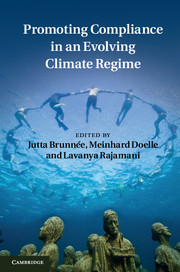Book contents
- Frontmatter
- Contents
- Contributors
- Preface
- Abbreviations
- Introduction: The role of compliance in an evolving climate regime
- Part I Context
- Part II The Kyoto compliance system: Features and experience
- 4 Key features of the Kyoto Protocol’s compliance system
- 5 Experience with the facilitative and enforcement branches of the Kyoto compliance system
- 6 Experiences with Articles 5, 7, and 8 defining the monitoring, reporting and verification system under the Kyoto Protocol
- Part III Compliance and the climate regime: Issues, options, and challenges
- Part IV A look forward
- Bibliography
- Index
5 - Experience with the facilitative and enforcement branches of the Kyoto compliance system
Published online by Cambridge University Press: 05 January 2012
- Frontmatter
- Contents
- Contributors
- Preface
- Abbreviations
- Introduction: The role of compliance in an evolving climate regime
- Part I Context
- Part II The Kyoto compliance system: Features and experience
- 4 Key features of the Kyoto Protocol’s compliance system
- 5 Experience with the facilitative and enforcement branches of the Kyoto compliance system
- 6 Experiences with Articles 5, 7, and 8 defining the monitoring, reporting and verification system under the Kyoto Protocol
- Part III Compliance and the climate regime: Issues, options, and challenges
- Part IV A look forward
- Bibliography
- Index
Summary
Introduction
Other contributions to this volume consider in some detail issues related to this chapter, which is the experience of the facilitative branch (FB) and the enforcement branch (EB) of the Kyoto compliance system. Among related issues covered in other chapters are compliance theory, the role of facilitation, enforcement, and transparency in MEA compliance, experience with compliance in other MEAs, and the design and general workings of the Kyoto compliance system. The overall purpose of this chapter is to reflect on the experience of the EB and the FB between 2006 and 2010 and to consider any lessons it may have to offer for compliance system design.
The primary purpose of reflecting on the experience of the two branches of the Kyoto compliance system is to consider improvements to the system, assuming it will continue to focus on emission reduction targets by developed countries and related developed country obligations. A secondary purpose is to provide a basis for considering whether the current compliance system could take on some or all of the compliance challenges arising from new commitments expected under the post-2012 regime. Would the Kyoto compliance system be suited to dealing with finance and other assistance to be provided by developed countries? What about commitments from developing countries, such as mitigation actions and adaptation projects funded through United Nations Framework Convention on Climate Change (FCCC) financial mechanisms, or national reporting on emissions?
- Type
- Chapter
- Information
- Promoting Compliance in an Evolving Climate Regime , pp. 102 - 121Publisher: Cambridge University PressPrint publication year: 2011
- 1
- Cited by



